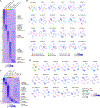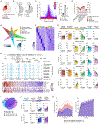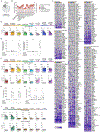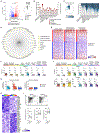Impact of Genetic Polymorphisms on Human Immune Cell Gene Expression
- PMID: 30449622
- PMCID: PMC6289654
- DOI: 10.1016/j.cell.2018.10.022
Impact of Genetic Polymorphisms on Human Immune Cell Gene Expression
Abstract
While many genetic variants have been associated with risk for human diseases, how these variants affect gene expression in various cell types remains largely unknown. To address this gap, the DICE (database of immune cell expression, expression quantitative trait loci [eQTLs], and epigenomics) project was established. Considering all human immune cell types and conditions studied, we identified cis-eQTLs for a total of 12,254 unique genes, which represent 61% of all protein-coding genes expressed in these cell types. Strikingly, a large fraction (41%) of these genes showed a strong cis-association with genotype only in a single cell type. We also found that biological sex is associated with major differences in immune cell gene expression in a highly cell-specific manner. These datasets will help reveal the effects of disease risk-associated genetic polymorphisms on specific immune cell types, providing mechanistic insights into how they might influence pathogenesis (https://dice-database.org).
Keywords: DICE; GWAS; eGenes; eQTLs; gene expression; genetic variants; human immune cells; immunology; sex.
Copyright © 2018 Elsevier Inc. All rights reserved.
Conflict of interest statement
DECLARATION OF INTERESTS
The authors declare no competing interests.
Figures






References
-
- Bacher P, Heinrich F, Stervbo U, Nienen M, Vahldieck M, Iwert C, Vogt K, Kollet J, Babel N, Sawitzki B, et al. (2016). Regulatory T Cell Specificity Directs Tolerance versus Allergy against Aeroantigens in Humans. Cell 167, 1067–1078 e1016. - PubMed
-
- Ballouz S, Verleyen W, and Gillis J (2015). Guidance for RNA-seq co-expression network construction and analysis: safety in numbers. Bioinformatics 31, 2123–2130. - PubMed
Publication types
MeSH terms
Grants and funding
LinkOut - more resources
Full Text Sources
Other Literature Sources
Molecular Biology Databases
Miscellaneous

